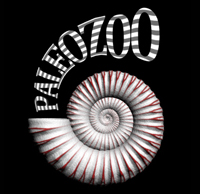The Cambrian period is of particular interest to evolutionary biology as it represents a problematic boundary line in the emergence of animal life on Earth. At the time Darwin was writing “On the Origin of Species” this boundary was stark – below the Cambrian strata there were no signs of animal life but from the Cambrian strata onwards there were not only signs of animal life but life in such abundance and complexity that it gave rise to the term “Cambrian Explosion”. Suddenly creatures with remarkably good vision and mobility were moving throughout the oceans of the planet. Predator and prey had clearly emerged with the associated developments of armoured limbs and protective shells. Darwin understood this to be a problem for his own theory on evolution which necessarily pointed to a long line of antecedents from which the Cambrian organisms could arise. Where were these ancestors?
Anomalocaris canadensis
Another puzzle presented by the Cambrian biota is that most modern animal phyla (basal body plans) were established during this period. In addition it is speculated that many other now extinct phylums also appeared at this time. Why so much diversityand disparity so suddenly?
Marrella splendens
Darwin hoped that the problem of ancestry would be resolved by the future identification of pre-Cambrian fossilized remains. This hope was partially vindicated in 1957 by the discovery of Charnia masoni, a multi-cellular, complex organism found within strata that later became known as the Ediacaran period (635 - 543 Mya). Subsequently many organisms from this period have been found around the world. These are clearly simpler lifeforms from an earlier time period but it has been hard for paleontology to trace any clear lineages between Ediacaran and Cambrian organisms and the differences in form and complexity remain stark over such a relatively short evolutionary period. Until clear connections can be ascertained the assumption has to be that the Ediacaran and Cambrian organisms may not be related.
Opabinia regalis
Phylogenetic studies have also helped to partially resolve the ancestry puzzle. Reverse modelling of genetic mutation rates clearly indicates the presence of ancestral organisms to the Cambrian lifeforms, reaching even further back in time than the Ediacaran period – essentially meaning that even if we can’t see them we can know that they were there. But still the question remains: Where are the remains?
Another observation has been that the early Cambrian period is defined by the appearance of fragments of hardened shelly structures (Small Shelly Fossils) and that this biomineralisation of part of an organism facilitated subsequent fossilization. Conversely earlier lifeforms were overwhelmingly soft bodied and therefore left no trace in an already patchy fossil record. This may have been the case to some extent but soft bodied organisms (although rare) have been found throughout the fossil record and at times in extraordinary detail – especially those preserved in fine silt matrixes known as “Lagerstatte Deposits” such as the Burgess Shale. So why no trace whatsoever of relatively complex soft bodied animals prior to the Cambrian period?
Hallucigenia sparsa
The relatively complex animals that must have preceded the Cambrian period may well have been soft bodied and difficult to preserve but to leave no trace is problematic. The stratigraphic record appears to have been almost wiped clean, so much so that it has been speculated that a great extinction event occurred between the Ediacaran and Cambrian periods wiping out all signs of earlier animal life.
One possible solution to this puzzle might be conjectured by assessing where these putative early animals might have existed on the planet. Is it possible that the first stages of the evolution of animal life might have been confined to the deep ocean trenches?
Pikaia gracilens
Throughout its turbulent history the most stable environments on the planet have been found within these trenches and it is hypothesised that life itself may have originated in or around deep sea vents. Even if life originated elsewhere it could still be the case that complex organisms were able to evolve in these relatively stable environments -feeding on the energies and minerals that are constantly emitted from these vents. From here such organisms would even be able to radiate around the planet along the network of tectonically interconnected deep sea trenches. Over time these same organisms might have progressively advanced on the emerging continental shelves and once there be able to generate fossilized remains. Crucially, prior to that conjectured radiation all remains would have fallen to the deep ocean floor.
Wiwaxia corrugata
The ocean floor is surprisingly young in geological terms (~125 Mya) due to the processes of the Deep Carbon Cycle – resulting in large portions of oceanic crust being subducted back down into the Earth’s mantle. Any organism that does become preserved within oceanic strata will correspondingly be subducted into the mantel. Speculatively the elusive pre-Cambrian organisms might have existed within these deep sea zones - evolving and adaptively radiating around the world - but have left no trace.
Over the last 150 years much headway has been made on these fundamental questions but they still remain unresolved. Determining how the Cambrian biota arose in such disparity and diversity remains pivotal in our understanding of the mechanics of evolution and consequently the Cambrian period continues to be a focal point for evolutionary biology.






